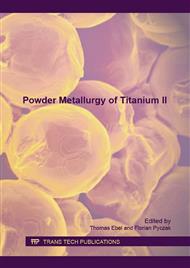[1]
M. Shiomi, A. Yoshidome, F. Abe, K. Osakada, Finite element analysis of melting and solidifying processes in laser rapid prototyping of metallic powders, Int. J. Mach. Tool Manu. 39 (1999) 237- 252.
DOI: 10.1016/s0890-6955(98)00036-4
Google Scholar
[2]
C. Qiu, C. Panwisawas, M. Ward, H. C. Basoalto, J. W. Brooks and M. M. Attallah, On the role of melt flow into the surface structure and porosity development during selective laser melting, Acta Mater. 96 (2015) 72-79.
DOI: 10.1016/j.actamat.2015.06.004
Google Scholar
[3]
I. Roberts, C. Wang, R. Esterlein, M. Stanford, D. Mynors, A three-dimensional finite element analysis of the temperature field during laser melting of metal powders in additive layer manufacturing, Int. J. Mach. Tool Manu. 19 (2009) 916-923.
DOI: 10.1016/j.ijmachtools.2009.07.004
Google Scholar
[4]
P. Vora, K. Mumtaz, I. Todd, N. Hopkinson, AlSi12 in-situ alloy formation and residual stress reduction using anchorless selective laser melting, Additive Manu. 7 (2015) 12-19.
DOI: 10.1016/j.addma.2015.06.003
Google Scholar
[5]
M. v. Allmen, A. Blatter, Laser-Beam Interactions with Materials: Physical Principles and Applications, second ed., Springer Science & Business Media, (2013).
Google Scholar
[6]
M. Geiger, K. -H. Leitz, H. Koch, A. Otto, A 3D transient model of keyhole and melt pool dynamics in laser beam welding applied to the joining of zinc coated sheets, Prod. Engineer. 3 (2009) 127- 136.
DOI: 10.1007/s11740-008-0148-7
Google Scholar
[7]
F. -J. Gürtler, M. Karg, K. -H. Leitz, M. Schmidt, Simulation of laser beam melting of steel powders using the three-dimensional Volume of Fluid Method, Phys. Procedia 41 (2013) 881-886.
DOI: 10.1016/j.phpro.2013.03.162
Google Scholar
[8]
C.W. Hirt, B.D. Nichols, Volume of fluid (VOF) method for the dynamics of free boundaries, J. Comput. Phys. 39 (1979) 201-225.
DOI: 10.1016/0021-9991(81)90145-5
Google Scholar
[9]
J.W. Cahn, J.E., Hilliard, Free energy of a nonuniform system. I. Interfacial Free Energy, J. Chem. Phys. 28 (1958) 258-267.
DOI: 10.1063/1.1744102
Google Scholar
[10]
P. -F. Paradis, T. Ishikawa, S. Yoda, Non-Contact measurements of surface tension and viscosity of niobium, zirconium, and titanium using an electrostatic levitation furnace, Int. J. Thermophys. 23 (2002) 825-842.
Google Scholar
[11]
X. Bai, M. Li, Nature and extent of melting in superheated solids: Liquid-solid coexistence model, Phys. Rev. B 72 (2005) 052108.
DOI: 10.1103/physrevb.72.052108
Google Scholar
[12]
D.P. Woodruff, The Solid-Liquid Interface, first ed. Cambridge University Press, (1973).
Google Scholar
[13]
I. Katzarov, S. Malinov, W. Sha, Finite element modeling of the morphology of β to α phase transformation in Ti-6Al-4V alloy, Metall. Mater. Trans. A 33 (2002) 1027-1040.
DOI: 10.1007/s11661-002-0204-4
Google Scholar
[14]
W. Kurz, D.J. Fischer, Fundamentals of Solidification, third ed., Trans. Tech. Publications, (1992).
Google Scholar
[15]
L. Thijs, F. Verhaeghe, T. Craeghs, J.V. Humbeeck, J. -P. Kruth, A study of the microstructural evolution during selective laser melting of Ti-6Al-4V, Acta Mater. 58 (2010) 3303-3312.
DOI: 10.1016/j.actamat.2010.02.004
Google Scholar
[16]
I. Steinbach, Phase-field models in materials science, Model. Simul. Mater. Sci. Eng. 17 (2009) 073001.
DOI: 10.1088/0965-0393/17/7/073001
Google Scholar
[17]
U. Grafe, B. Böttger, J. Tiaden, S.G. Fries, Coupling of multicomponent thermodynamic databases to a phase field model: Application to solidification and solid state transformations of superalloys, Scr. Mater. 42 (2000) 1179-1186.
DOI: 10.1016/s1359-6462(00)00355-9
Google Scholar
[18]
J.J. Hoyt, M. Asta, A. Karma, Atomistic and continuum modeling of dendritic solidification, Mater. Sci. Eng. R-Rep. 41 (2003) 121-163.
Google Scholar
[19]
E.J. Lavernia, T.S. Srivatsan, The rapid solidification processing of materials: Science, principles, technology, advances, and applications, J. Mater. Sci. 45 (2009) 287-325.
DOI: 10.1007/s10853-009-3995-5
Google Scholar
[20]
Sente Software Ltd. JMatPro 8 Demo: http: /www. sentesoftware. co. uk, U.K. 2012, (Accessed 2 Jul. 2015).
Google Scholar
[21]
Thermo-Calc Software: TTTI2 Thermotech Ti-based Alloys database version 2, (Accessed 9 Mar 1998).
Google Scholar
[22]
M. Simonelli, Y. Tse, C. Tuck, On the texture formation of selective laser melted Ti-6Al-4V, Metall. and Mater. Trans. A 45 (2014) 2863-2872.
DOI: 10.1007/s11661-014-2218-0
Google Scholar
[23]
N. Saunders, A.P. Miodownik, CALPHAD (Calculation of Phase Diagrams): A Comprehensive Guide, first ed., Pergamon Materials Series, Elsevier Science, (1998).
DOI: 10.1016/s1470-1804(13)60012-7
Google Scholar
[24]
B. van Hooreweder, D. Moens, R. Boonen, J. -P. Kruth, P. Sas, Analysis of fracture toughness and crack propagation of Ti-6Al-4V produced by selective laser melting, Adv. Eng. Mater. 14 (2012) 92-97.
DOI: 10.1002/adem.201100233
Google Scholar


